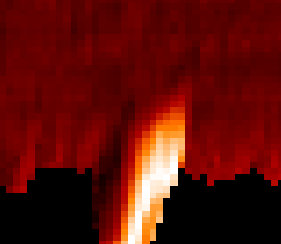Click on image for full size
National Astronomical Observatory of Japan
Solar Storm seen by SOHO
News story originally written on April 10, 1997
The Solar and Heliospheric Observatory (SOHO) satellite took pictures of a large
eruption that occurred on the Sun at 10:00am, Monday, April 7. The matter that
was spewed out of the sun travelled through space in an interplanetary magnetic
cloud. This magnetic cloud travels at over 1 500 000 miles per hour.
A portion of this cloud struck Earth at 8:00pm last night, April 9.
The storm is of typical strength for the Sun, and the magnetic cloud has posed
no danger to the Earth or those astronauts and cosmonauts at the Mir Space
Station.
The storm is expected to increase auroral activity at high latitudes over the
next few days. Solar storms sometimes knock out power grids and radios, though
this one has not done so.
The solar eruption is called a coronal mass ejection. Coronal mass ejections
blow a hole in the Sun's corona and spew out solar particles. The solar
eruption was also included a solar flare eruption which caused the sun to
experience a supersonic wave throughout its corona.
SOHO is a satellite that is about 900 000 miles from Earth. Its main mission is
to study the sun. It takes photos of the sun and measures solar particles that
may pass by the satellite.
You might also be interested in:

Have you ever wondered why your favorite radio station doesn't always come in? Solar activity, such as solar wind, sometimes causes this and other problems. Scientists are trying to find ways to understand
...more
Space activity in the last year was spectacular! 1997 in space - people are saying this year is second only to 1969 when the U.S. first landed a man on the Moon. Hang on to your hats as we look at the
...more
There just seem to be so many exciting things happening in space these days! One new discovery is that there are storms on the Sun very similar to our own tornadoes! This discovery was made by ESA/NASA
...more
The GOES-K satellite will be launched from the Cape Canaveral Air Station on April 24. The satellite is one that takes images of the earth's atmosphere which allows meteorologists to make forecasts based
...more
The Solar and Heliospheric Observatory (SOHO) satellite took pictures of a large eruption that occurred on the Sun at 10:00am, Monday, April 7. The matter that was spewed out of the sun travelled through
...more
Astronomers have identified another exoplanet, that is, a planet outside our solar system. This makes a total of 102 exoplanets that have so far been found by astronomers! The astronomers that identified
...more
Thanks to a couple of telescopes, everyone on the internet can browse through almost 2 million images. Stars throughout the sky were photographed by the Two-Micron All Sky Survey (2MASS) and are now available
...more
Earth may look perfectly spherical from space, like a giant marble, but it actually isn't! Instead, our planet is wider around the equator because matter is forced out as Earth spins (just as you feel
...more














